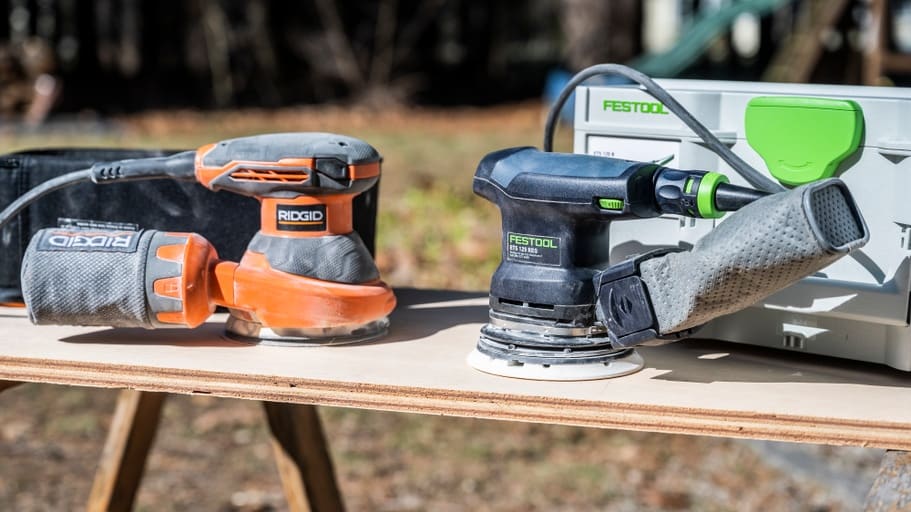 — Recommendations are independently chosen by Reviewed’s editors. Purchases you make through our links may earn us a commission.
— Recommendations are independently chosen by Reviewed’s editors. Purchases you make through our links may earn us a commission.When it comes to woodworking, there aren’t many tools that will save you as much time and soreness as a random orbital sander. Properly hand sanding a woodworking project can take hours. A good orbital sander cuts that time down significantly, leaving you with a professional-looking finish.
Nearly all of the major power tool manufacturers offer a random orbital sander, and it can be difficult to decide which one will work best for you. We put nine different orbital sanders to the test to find out which ones will actually save you time and energy, and which ones to avoid.
Our Best Overall pick is the Dewalt DWE6421K Random Orbital Sander (available at Amazon for $66.64), which is an impressive, fast-moving sander at a reasonable price, perfect for any homeowner and weekend warrior. However, if you’re a pro looking to invest in a higher-end line of tools, then the Festool Random Orbital Sander (available at Amazon) is worth serious consideration.
Here are the best random orbital sanders we tested, ranked in order
- Dewalt DWE6421K Random Orbital Sander
- Festool 576993 Random Orbital Sander
- Porter Cable Random Orbital Sander
- Bosch ROS20VSC Palm Sander
- Milwaukee Corded Random Orbital Sander
- Makita BO5041K Random Orbital Sander
- Ryobi 290G Random Orbital Sander
- Skil 2R211601 Random Orbital Sander
- Craftsman CMEW231 Random Orbital Sander
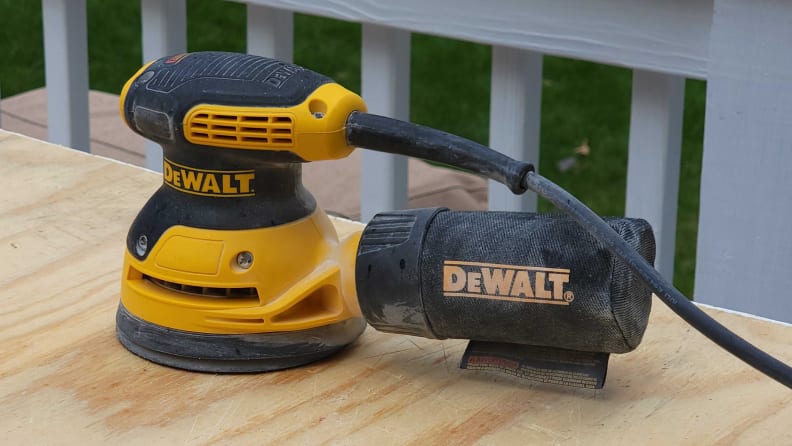

This Dewalt random orbital sander's power and utility earned our Editor's Choice Award.
The Dewalt orbital sander is one of our top performers. It crushed its competition in terms of speed, removing the paint from a board, in about three minutes whereas the other random orbital sanders in this guide took around five. It is comfortable to hold in multiple positions, and its dust collection system does a decent job, particularly when connected to a shop vac. This is a great sander to pick up for personal use.
There are only two small knocks against it.
First, The Dewalt can only operate at a single speed. This certainly isn’t a dealbreaker, as I run my sander at top speed 99% of the time anyway. However, the second, larger issue is that the same power that made such short work of the painted board makes this sander a bit difficult to control. Keeping it under control requires more effort than I had to use with most of the other sanders in this guide. However, its control issues aren't such that I recommend against buying it. This is a powerful random orbital sander that offers impressive performance.
Pros
-
Powerful, fast 3-amp motor
-
Quality dust collection
Cons
-
Single speed
-
Jumps and pulls when sanding
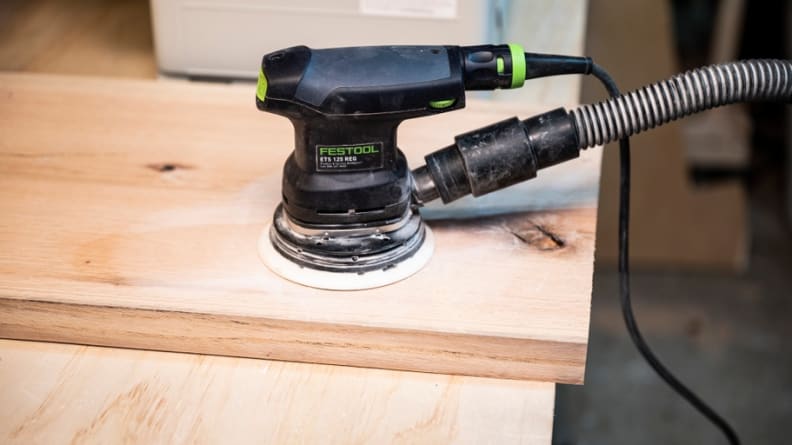

The Festool Random Orbital Sander is a outstanding choice for anyone interested in investing in professional-grade tools.
If you look only at the results of our testing, then the Festool random orbital sander is hands down the winner. It is smooth, powerful, and does a great job with dust collection. While it wasn’t the fastest sander we tested, it was near the front of the pack. And, that speed and power is easy to keep under control. If performance is your only metric for buying a tool, then consider getting the Festool, because it’s the best orbital sander I’ve ever used.
However, for most of us, performance isn’t the only metric, and it’s here that Festool has two major knocks against it. The first is price. At over $200, the Festool random orbital sander is three to four times more expensive than the other sanders we tested. Is this sander three times better than the Ridgid? If you’re not a professional, probably not—and even if you are, still probably not.
The second knock against Festool is that it works with a lot of proprietary materials. It’s designed to work with the Festool dust collector, for example. I was able to find a connector among my hose fittings that worked, but it wasn’t a tight seal, so I’m sure the dust collection would have been even better with the Festool collector. Festool also stepped away from the universal hole pattern in the sanding discs used by every other manufacturer. What this means is that you either have to poke new holes in the sandpaper (which is what we did), or buy Festool sandpaper, which is only available at authorized Festool dealers.
If you’re a professional looking for a top-of-the-line product, and you’re interested in going all-in on the Festool lineup, then you probably won’t find a better sander. However, if you’re a homeowner, or just looking for a standalone sander, then Festool is probably priced out of your comfort zone.
Pros
-
Smoother operation
-
Excellent dust collection
-
Powerful motor
Cons
-
Price
-
Some proprietary accessories needed
How We Tested Random Orbital Sanders

The best way to test any power tool is to put it to work.
The Tester
Hi, I’m Jean Levasseur. I’m a former conveyor mechanic, current property manager, hobbyist woodworker, and writer. I come from a family of tool-users—my grandfather was a carpenter, my father owned an excavation company, and my mother was a mechanic. Between growing up working for my family’s businesses and then moving onto my own projects, I’ve used most tools you’ve heard of and quite a few that you haven’t.
The Tests
There’s really only one way to test sanders, and that’s to sand. We put the sanders through a series of tests to find out how quickly they removed material, how much control we had while sanding, and how well the dust collection worked. Of course, while testing, we used all of the proper safety equipment: eye protection, a dust mask, and hearing protection. I also had my shop’s air filter running to keep down on the clouds of dust.
The first test was to strip paint off of a 12-inch by 8-inch pine board. I clamped the board to my workbench, and sanded using 80-grit sandpaper until all of the paint was gone from one face, keeping track of how long each sander took.
Once the paint was stripped from the board, I switched to 120-grit paper and sanded the wood of the board smooth, looking for a quality, stain-ready finish. I also sanded along the edges of the board, looking for how easy it was to keep a perpendicular edge on the board.
During both of these tests, I observed the dust collection. First, I used the integrated dust collector that comes with every sander. I kept track of how much paint and sawdust was left behind on my workbench, as well as the size of the dust cloud surrounding my work area. I tested using the integrated dust collection for about a minute. None of them are great, and I didn’t want to completely fill my shop with dust. Then I connected the sander to my shop vac to finish the testing, watching how well that dust collection worked.
I also paid close attention to the smoothness and control of the sander. How much effort did it take to keep the sander under control? Did the sander jump and skip across the board when it got near the edge or corners? Were there numerous comfortable positions to hold the sander so that I could give my hands a break periodically? A ridiculously powerful sander that can strip paint from a board in under a minute is no good if you can’t keep it under control.
Finally, I tested the polishing ability of each orbital sander on a piece of distressed metal. Surprisingly, there was no noticeable difference in the polishing performance of each sander, so this wound up not being a meaningful part of the rankings.
What You Should Know About Buying a Random Orbital Sander
How Does a Random Orbital Sander Work?
Random orbital sanders spin a circular sanding disc in a random pattern. The benefit of this is that it leaves behind fewer swirls, scratches and general sanding marks from the paper, whether you're sanding with the grain or not.
This results in an easier progression through the grits than hand sanding or using a belt sander, and leaves a cleaner, smoother finish. While these aren’t meant to remove a huge amount of material like a belt sander will, they are great for finish work.
Sanding Performance is Surprising Consistent
I was shocked at how well each of the sanders actually sanded in our testing. None of these machines failed the test, and if you needed to get a large sanding project done with any of them, they would all do the job.
Our rankings mostly came down to differences in comfort, control, and dust collection, not the actual sanding performance itself.
Dust Collection is a Major Priority
Good dust collection in an orbital sander is one of the most important factors to consider. There’s nothing worse than sanding in the middle of a cloud of sawdust that just keeps growing by the minute.
While you should always wear a dust mask when sanding to protect your lungs, the more you can keep the dust down, the better off you’ll be. All sanders that I’ve seen come with some sort of dust collection bag, but frankly none of them are very good.
If you’re planning to do any serious amount of sanding, invest in a shop vac with hoses and fittings that will connect to your sander.
Should You Opt For a Battery-powered or Corded Sander?
Another consideration is whether you want a battery-powered or corded sander. This test was exclusively for corded sanders, but many of these companies also make battery-powered versions.
A battery-powered sander is going to offer portability and flexibility in terms of where you can sand. However, in my experience, sanding is typically a stationary project. You set up a sanding station and go to town.
Also, I tend to build projects in batches, and as such, I’m usually sanding for longer than the 30-40 minute runtime of a battery sander. So for me, the limitation of a cord is offset by the unlimited runtime.
Having a corded sander also means that brand consistency is less important because you don’t need to have the same batteries across multiple tools. I would suggest that unless you know you have a need for a battery-powered sander, start with a corded one.
Can You Polish With a Random Orbital Sander?
In short, yes, you can. Numerous companies make dedicated hook and loop polishing pads specifically for orbital sanders.
One thing that you do need to be careful of is the speed at which you’re polishing. Check your owner’s manual to make sure that sander is rated for polishing. If you think that polishing is going to be a major use for the sander, invest in one with a variable speed to give you more control.
Can You Wet Sand With a Random Orbital Sander?
Unless your sander’s manual specifically says that you can use it to wet sand, don’t.
Using power tools around water is a good way to either short out the machine or electrocute yourself. You also run the risk of shortening the life of your sander through corrosion.
Other Random Orbital Sanders We Tested
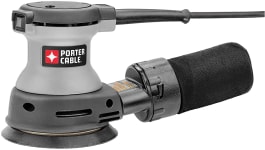
The more tools I test, the more impressed I am with Porter Cable’s entire lineup, and the orbital sander is no exception. The shining success of this sander is the dust collection, which was one of the best among all that we tested. The integrated bag dust collection lets out some dust, but much less than many of the others. When attached to the shop vac, there was almost no cloud from the sander. It also comes with a flexible vacuum connector that can fit with multiple different hose sizes, which is a nice bonus.
Performance-wise, the Porter Cable random orbital sander fell right in the middle, coming in around the five minute mark to strip the board of all its paint. It’s smooth and easy to control without a lot of extra effort, which bodes well for longer sanding sessions.
The biggest complaint that I have with this sander is the comfort. It had multiple ways to hold it, but the top handle isn’t great. It’s flat and not contoured to a hand, so holding from the top long-term is difficult. If you’re like me and prefer to hold the body of the sander, this may not be a deal breaker, but it is something to consider.
Pros
-
Excellent dust collection
-
Smooth operation
Cons
-
Comfort of handle

This is actually the sander that I have personally, and its performance made me pretty happy I bought it. It’s one of the smoothest and easiest to control of all of the sanders that we tested, something that’s born out in my experience with multi-hour sanding sessions.
The handle is comfortable and contoured, providing numerous ways to hold the sander with either hand. The dust collection is solid, falling right in line with the average for all of the sanders that we tested. It has a variable speed, a vacuum attachment, and even a nice carrying bag.
The biggest drawback of this sander is the power. You can hear the power difference between this and some of the others. This was the slowest sander to complete the tasks, by about 20%. Which makes sense, given that it has a 2.5-amp motor versus the 3-amp of some of the higher ranked sanders. That lower power allows some of the better control that this sander features, but you have to decide if it’s worth the tradeoff.
All in all, this is a quality sander that most homeowners would be more than happy with.
Pros
-
Very smooth operation
-
Quality dust collection
Cons
-
Underpowered
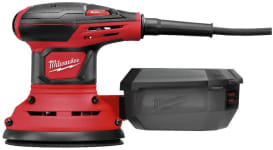
Milwaukee is typically known for its battery-powered tools, but it does have an extensive line of corded tools as well. This is another powerful, 3-amp sander, but unfortunately, that power does not translate into significantly faster sanding times.
However, it does come with all of the control drawbacks of a more powerful sander. When it’s running smoothly, it runs very smoothly, but when it jumps and pulls, it pulls hard enough that I would be concerned about accidentally causing damage in tight areas.
What’s more, the dust collection on this sander simply isn’t very good. Even with the vacuum hooked up, the Milwaukee left behind quite a bit more paint and sawdust than most of the others.
Unfortunately, despite Milwaukee's reputation, and my personal affinity for their tools, the corded random orbital sander just doesn’t measure up.
Pros
-
Powerful sanding
-
Comfortable grips
Cons
-
Dust collection
-
Sander jumps and pulls
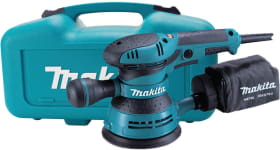
The Makita random orbital sander has two unique features among the sanders that we tested, one good, one not so good.
The good feature is the additional handle that comes with the sander. This straps to the body and allows a whole bunch of new ways to hold the sander, providing both improved control and comfort. This is a feature that I loved, and I’m going to be looking into whether I can add one of these on to my sander.
The other unique feature is a trigger mechanism to operate it instead of an on-off switch. It’s an interesting idea, but it simply doesn’t work that well. A sander typically isn’t a tool that you want to turn on and off quickly like a saw or a drill. When it’s time to sand, you turn it on. The trigger does have an always on lock, but the fact that I always used it defeats the point of a trigger in the first place.
What’s more, the trigger is often in the way, almost no matter how you hold the sander. When holding it by the body, my hand continually bumped the trigger, disengaging the always-on lock and turning the sander off. This is one of those features that seems good on paper, but there’s a reason so few of Makita’s competitors use a trigger.
Add the annoyance of the trigger to mediocre dust collection, and this sander just misses the mark.
Pros
-
Excellent handle
-
Smooth operation
Cons
-
Trigger gets in the way
-
Mediocre dust collection
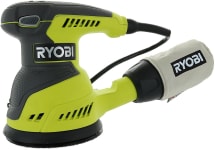
I had a previous generation of this sander for about eight years, and it did a fine job. This is one of those tools that does everything fine: nothing great, and nothing horrible. It’s a bit slower and less powerful than some of the other sanders. The dust collection works, but still leaves behind a decent amount of dust. It’s comfortable, easy to use, but does have a tendency to jump and pull occasionally.
At basically the same price as many of our higher rated sanders, I’d suggest looking elsewhere, but if you find it on sale, it’ll get the job done.
Pros
-
Comfortable use
Cons
-
Tendency to jump and pull
-
Mediocre dust collection
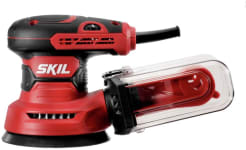
Like the Ryobi, the Skil random orbital sander is a decent quality machine that does the job it’s asked to do in mediocre fashion. It was right in the middle in terms of sanding speed and dust collection.
The handle and body are reasonably comfortable, though this is where the one major drawback of this sander comes out. When using the attached dust collector bag, it’s hard to hold the body. There just isn’t enough room between the bag and the cord.
All that said, though it’s $15-$20 cheaper than many of the others, you lose too much in performance to make this worth downgrading to.
Pros
-
Price
-
Comfortable handle
Cons
-
Dust collector bag in the way

Unfortunately, the Craftsman random orbital sander just doesn’t stand up. It’ll do the job of sanding, but it’s not overly comfortable to use, the dust collection isn’t very good, and it has a tendency to jump and pull without even the benefit of faster, more powerful sanding.
I’d avoid this machine if you can.
Pros
-
Will complete sanding tests
Cons
-
Jumps and pulls
-
Subpar dust collection
-
Underpowered
